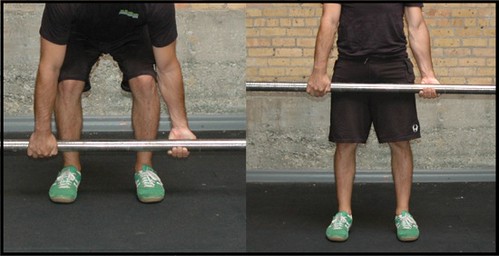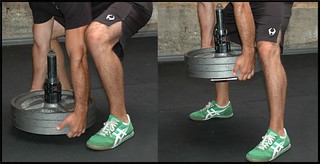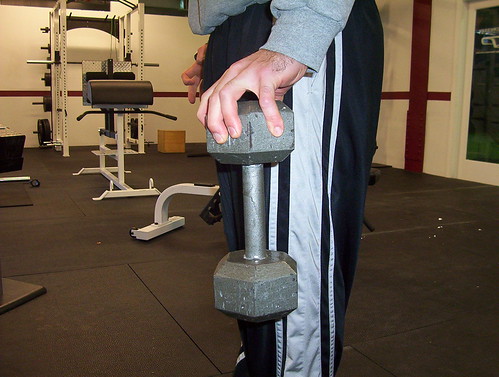A few weeks ago I presented at the Spurling Spring Seminar up in Kennebunk, Maine. The first presenter of the day, Portland based physical therapist Noah Harrison, blew me away with his talk on muscular tension.
Honestly, the only way his presentation could have been better is if he somehow included a pair of nunchucks.
Or a t-shirt cannon.
His message resonated with me and after he spoke I asked if he’d be interested in summarizing his thoughts in an article for my site. He was more than happy to oblige.
Enjoy (it’s REALLY good).

Tuning Tension: Getting the Most From Your Muscle
There are two aspects to what dictates the strength of a muscle; how big it is and how hard it can contract at any given moment, with any given movement. Keeping that in mind there are then two ways you can train a muscle to become stronger:
- Make it bigger and give it more leverage.
- Teach it to contract harder by creating more tension.
While hypertrophy obviously has its use, there are times our goal is simply to increase strength without having to buy a new wardrobe, or jump a weight class. There are also times we have a little more strength in our muscles as they already are, and it is simply a matter of getting them to work fully in the moment.
This article is about ways in which you can train your muscles to fire a little (or a lot) harder, instantaneously, and apply it to nearly any exercise you are performing.
Yes, you can practice tensing your muscles like a body builder during “X” movement, and if an EMG was attached to your area of focus it would read a spike.
The problem with consciously focusing on flexing your muscles during a movement is that this does produce increased tension locally where you are focusing, but often times at the expense of your performance. Quite often tensioning your muscles consciously while moving will result in you simply working harder, moving slower, and experiencing premature fatigue (1).
So how do you get your muscles to pump out more power without destroying your performance?
Simple: you will not do it consciously.
Instead you will do it reflexively. You will use the reflexive reactions you already have.
What I will map out are three body areas/actions that you can focus on with any given activity, and depending on what you do with these areas/actions will either elicit a reflexive increase or decrease in body wide muscular tension.
Again, this article will solely focus on increasing muscular tension.
The three areas/actions are:
- What you do with your breath.
- What you do with your hands.
- What you do with your face.
Now there is no better place to begin talking about changing bodily tension than talking about…
What You Do With Your Breath
The general rule is that if you want to increase muscular tension then either hold your breath or forcefully exhale.
The latter, a forceful exhale, is preferred.
Why?
First, let’s look at what is happening with both these situations.
In one case you hold your breath and barrel down (a valsalva maneuver) and in the other you forcefully exhale through resistance. In both situations you are jacking up your intra-abdominal pressure (IAP), which is necessary to keep your trunk stiff and give your limbs leverage with anything difficult.
Core strength is pressure production, and if you want to be strong, you need to be able to make a lot of it.
However the valsalva maneuver (VM) has a few significant draw backs. The most notable is that you really cannot do many repetitions this way. One rep, maybe, but once you get to two or three repetitions deep into an exercise you will need to breathe.
The second drawback is that a VM is associated with some negative cardiovascular effects, including a sharp increase in your heart rate, blood pressure, as well as an increased risk of cerebral hemorrhage (2). Again, if it doesn’t kill you, holding your breath is going to gas you quicker than necessary.
The third problem is that a VM is associated with an increased risk of incontinence in certain populations (3, 4), which is not desirable if you or your client is trying to be active. Nobody, regardless of what Adam Sandler says, likes to pee themselves, and especially in the middle of a fierce effort.
Performing a forced exhalation (FE) has none of these issues, and has been shown to be as equally effective at spiking your IAP as a VM (2).
Additionally, a forced exhalation has been shown to increase the activation of your abdominal wall (5), is as effective at stiffening the trunk as bracing your abdominals (6), and even result in an instantaneous increase the strength of your grip and several large muscle groups throughout the body (2, 7).
We all know that a tight midsection is necessary to keep the body from crumbling during a strenuous task, but the take home from this should be to focus less on bracing your abdomen consciously.
Just forcefully exhale with the movement, and the abs will kick in automatically.
You have to breathe anyway; you may as well make it work in your favor. The general rule is to exhale with effort, and ingrain it with the movement you are performing.
How do you ingrain it? Every movement has a sticking point, you simply exhale through it.
See the video below for a demonstration of how to ingrain this into any exercise.
What You Do With Your Hands
This one is pretty simple.
If you want to increase body wide muscular tension, maximally tense your hands, preferably in a fist. If you are holding something, grip it hard (very hard). As a result, the rest of your body will “grip” harder as well.
In matters of strength, this is very convenient, because very often we are gripping something and either trying to move it (A barbell, dumbbell, kettlebell, etc) or ourselves around it (a pull up or dip bar). Simply aim your attention on what you are already doing.
How or why does this work? It probably comes down to both the law of irradiation, and how your cerebral cortex is organized.
Irradiation is a principle stating that the activity of a group of muscles will have a ripple effect on its neighboring parts (8). Meaning as you clench your hand harder, not only does your forearm tighten up, but your whole arm and shoulder does as well.
Grip even harder and your whole torso will become engaged. If you are not already trying this I encourage you to begin.
This has actually been measured, as research has shown that the harder you grip your hands, the harder your rotator cuff fires (9, 10). This is convenient, because if you are gripping a hold of something you would really like your shoulder to grab a hold of your body as well. Not only does gripping effect your shoulder, but your body as a whole; postural stiffness will increase the harder you grasp an obect (11). The utility of these reflexive responses with any pressing movement should go without saying.
So that is one factor, how about the second; your brain?
Well what is known is that there is a very large sensory and motor representation of both your hands and your face in the brain. Google “Homunculus Man” and you will see a model representation of this. It is a distorted image demonstrating the density of neurons in our cerebral cortex as it relates to sensing and moving our bodies in our environments.
You can think about this as that your brain both perceives and interacts with the world primarily via your face and hands, so whatever you do at these places will reverberate throughout your body.
If your hands are relaxed, your body will be as well. If your hands are tensed, then your brain will take you seriously and give you more juice. And in matters of strength, we all want juice.
So now we come to our third and final place to consider…
What You Do With Your Face
You may have a hard time believing your face matters so much in terms of strength, but it is true.
Do not forget that strange little homunculus man. Remember; your brain thinks the vast majority of you is face and hands. What you do in these places will resonate through your body.
What you do with you face can be further broken down into three factors;
- Your eyes.
- Your jaw.
- Your facial expression as a whole.
Eyes
What you do at your eyes can be thought of as more steering your bodily tension than necessarily jacking it up or down.
It is well established that the body follows wherever the eyes gaze (12).
This means that if you look to the left, you will have a reflexive weight shift to the left, and the same goes for looking to the right, up or down. Although gymnasts, power lifters and weight lifters will use this often to their advantage to drive extension or flexion with a movement, the vast majority of us should stick to simply looking relatively forward with whatever movement we are performing.
So, for maximal tension; fix your eyes when doing something hard, and do not let them wander.
Jaw
Just as the tension in our hands seems to reverberate through our bodies, what we do at our jaws does as well.
No different than our hands, the amount of tension that we hold at our jaw has the ability to increase reflexive activity as distant as our forearms and calves (13, 14).
Yes you read that correctly; clench your jaw and your forearms and calves will fire harder. In fact, clenching your jaw has been shown to improve your athletic performance across varying endeavors, including a back squat and vertical jump (15, 16).
I would advise caution with this (and for some a mouthpiece), as some people have trouble relaxing their jaws then necessary engaging it. Other people may not have a fully congruent bite, and heavily clenching may cause more of a problem than a help.
Simply focus on setting your jaw and keeping your teeth touching firmly when you need more muscular effort.
Facial Expression
Think about it: setting your eyes and jaw is pretty much a game face now isn’t it?
Besides focusing on where your eyes look and keeping your mouth shut, it is common sense to be serious during a heavy or difficult lift.
Laughing is completely out, as it has been established that there exists a body-wide inhibition of muscular tension for up to 45 minutes after a bout of laughter (17, 18).
So, save the jokes for after the work is done.
Putting It All Together
Here it is; the meat and potatoes of it all.
If you want to increase body wide muscular tension, then simply:
- Exhale with resistance.
- Clench your fists.
- Fix your eyes.
- Set your jaw and be serious.
This comes down to learning to place your mental effort on these choice few factors with whatever challenging movement you are performing.
By doing this you set yourself up for the best chance at eliciting the highest potential your muscles and body as a whole has in that given movement, on that given day.
Integrate this into your training, and you will likely find that you become stronger not simply because your muscles have grown, but because they have learned to work together, better.
Enjoy!
[List of references below]
About the Author
 Noah is a Physical Therapist and Strength Coach based out of Portland, Maine.
Noah is a Physical Therapist and Strength Coach based out of Portland, Maine.
He is the owner of Portland Integrative Physical Therapy, through which he provides one-on-one musculoskeletal rehabilitation with a holistic, full body approach.
Noah has extensive training in a variety of rehabilitative approaches, and combines this with progressive strength training in order to build and restore strong and capable individuals.
He lives in Portland, Maine with his wife Heidi and their young daughter, and can best be reached via his website www.portlandintegrativept.com and email [email protected]
References
- Makaruk, H, Porter, JM “Focus of Attention for Strength and Conditioning Training” Strength and Conditioning Journal Feb 2014, 36:1 16-22
- Ikeda, ER, et al “The Valsalva Maneuver Revisted: the Influence of Voluntary Breathing on Isometric Muscle Strength” J Strength Cond Res 2009 Jan: 23(1): 127-132
- Nitti VW, et al “Correlation of Valsalva leak point pressure with subjective degree of stress urinary incontinence in women” J Urol 1996 Jan; 155(1): 281-5
- Peschers UM, et al “Difference between cough and Valsalva leak-point in stress incontinent women” Neurourol Urodyn 2000; 19(6): 677-81
- Ishida et al “Maximum expiration activates the abdominal muscles during side bridge exercises” J Back Musculoskeletal Rehabil. 2015; 27(4): 481-4
- Ishida et al “Comparison between the effectiveness of expiration and abdominal bracing maneuvers in maintaining spinal stability following sudden trunk loading” J Electromyogr Kinesiol 2016 Feb; 26: 125-9
- Li S, et al “Forced ventilation increases variability of isometric finger forces” Neurosci Lett 2007 Feb 2; 412(3): 243-7
- Gontijo LB, et al “Evaluation of Strength and Irradiated Movement Pattern Resulting from Trunk Motions of the Proprioceptive Neuromuscular Facilitation” Rehabilitation Research and Practice Volume 2012, 6 pages
- Sporrong H, et al “Influences of handgrip on shoulder muscle activity” Eur J Appl Occup Physiol 1995; 71(6): 485-92
- Sporrong H, et al “Hand grip increases shoulder muscle activity, an EMG analysis with static hand contractions in nine subjects” Acta Orthop Scand 1996 Oct: 67(5): 485-90
- Ustinova KI, et al “Postural stabilization by gripping a stick with different force levels” Gait & Posture 2013 May: 38(1): 97-103
- Ivanenko YP, et al “Effect of gaze on postural responses to neck proprioceptive and vestibular stimulation in humans” Journal of Physiology 1999; 519(1): 301-314
- Takashi T, et al “Modulation of H reflexes in the forearm during voluntary teeth clenching in humans” European Journal of Applied Physiology 2003 Nov; 90(5-6): 651-3
- Miyahara T, et al “Modulation of human soleus H reflex in association of voluntary clenching of the teeth” J Neurophysiol 1996 Sep; 76(3): 2033-41
- Ebben, WP, et al “Jaw clenching results in concurrent activation potentiation during the countermovement jump” J Strength Cond Res 2008 Nov; 22(6): 1850-4
- Ebben WP, et al “Kinetic analysis of concurrent activation potentiation during back squats and jump squats” J Strength Cond Res 2010 Jun; 24(6): 1515-9
- Paskind, J “Effects of laughter on muscle tone” Arch Neurol Psychiatry 1932; 28: 623-8
- Overeem S, et al “Is motor inhibition during laughter due to emotional or respiratory influences?” Psychophysiology 2004; 41: 254-8


 thin plate or two and then load a few heavier plates on the loading pin, and finally lock down the apparatus with the collars on the top. Straddle the load, slide your fingers underneath both sides of the bottom plate, and lift it up a few inches. Be careful when you set it down to do it evenly so as to not crush your fingers.
thin plate or two and then load a few heavier plates on the loading pin, and finally lock down the apparatus with the collars on the top. Straddle the load, slide your fingers underneath both sides of the bottom plate, and lift it up a few inches. Be careful when you set it down to do it evenly so as to not crush your fingers.



